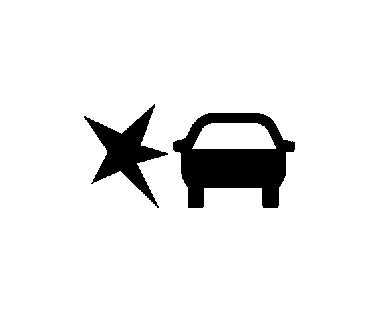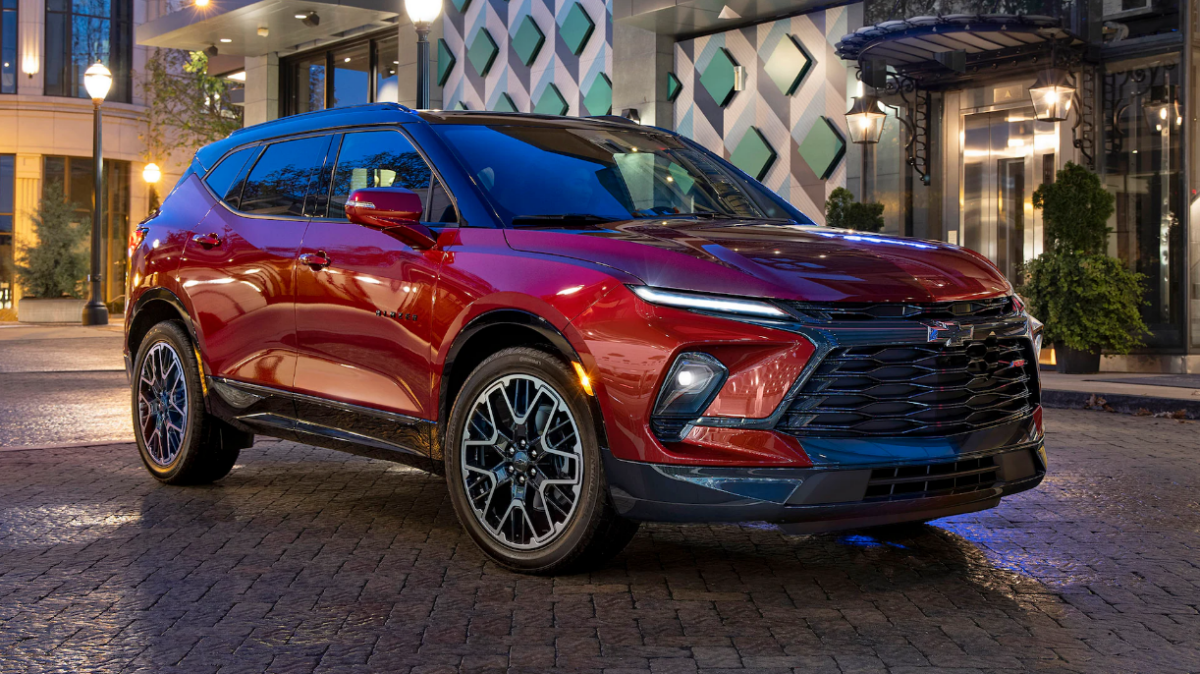Automatic Brake System: 2023 Chevrolet Blazer Driving Owner’s Manual
An advanced Automatic Brake System comes standard on the 2023 Chevrolet Blazer, which changes the way owners drive. This cutting-edge technology makes the roads safer by helping with braking automatically in dangerous scenarios. The Chevrolet Blazer’s Automatic Brake System uses sensors and algorithms to find possible accidents and apply the brakes before they happen. This system takes a proactive approach to accident prevention by integrating smoothly with the car’s current safety features. People who drive can now rest easy knowing that their car has the most up-to-date safety features. The Chevrolet Blazer 2023 Automatic Brake System is made to work quickly and effectively, lowering the chance of accidents and reducing the severity of impacts. With its easy-to-use features, this system improves the general responsiveness and dynamics of driving, making every trip safer and smoother. The fact that Chevrolet put this technology into their cars shows how committed they are to safety and new ideas. It sets a new bar for excellence in cars. The 2023 Blazer Automatic Brake System is the way of the future when it comes to driving. It combines safety and style in a way that is seamless.
2023 CHEVROLET BLAZER Specs, Price, Features, Mileage (Brochure)
Automatic Braking
Safe Driving Techniques
If FPB detects it is about to crash into a pedestrian directly ahead, and the brakes have not been applied, FPB may automatically brake moderately or brake
hard. This can help to avoid some very low-speed pedestrian crashes or reduce pedestrian injury. FPB can automatically brake to detect pedestrians between 8 km/h (5 mph) and 80 km/h (50 mph). Automatic braking levels may be reduced, under certain conditions, such as higher speeds. If this happens, Automatic Braking may engage the Electric Parking Brake (EPB) to hold the vehicle at a stop. Release the EPB. A firm press of the accelerator pedal will also release Automatic Braking and the EPB.
Warning
FPB may alert or automatically brake the vehicle suddenly in situations where it is unexpected and undesired. It could falsely alert or brake for objects similar in shape or size to pedestrians, including shadows. This is normal operation and the vehicle does not need service. To override Automatic Braking, firmly press the accelerator pedal, if it is safe to do so.
Automatic Braking can be disabled through vehicle personalization. To view available settings for this feature, touch the Settings icon on the infotainment home page. Select “Vehicle” to display the list of available options and select “Collision/Detection Systems.
Warning
Using the Front Pedestrian Braking system while towing a trailer could cause you to lose control of the vehicle and crash. Turn the system to Alert or Off when towing a trailer.
Cleaning the System
If FPB does not seem to operate properly, cleaning the outside of the windshield in front of the rearview mirror may correct the issue.
Brake System Tips
Chevy Blazer Safety
Maintaining and caring for your vehicle’s brake system is crucial for safety and optimal performance. Here are some general tips for taking care of the brake system in a vehicle like the Chevrolet Blazer or any other car:
- Regular Inspections:
- Periodically inspect the brake pads, rotors, and brake lines for wear and damage.
- Check for brake fluid leaks around the master cylinder and brake calipers.
- Brake Fluid Level:
- Ensure that the brake fluid level is within the recommended range. Low brake fluid can affect braking performance.
- Brake Fluid Quality:
- Check the brake fluid for discolouration or contamination. Brake fluid should be clear and free from debris.
- Brake Pad Thickness:
- Keep an eye on the thickness of the brake pads. Replace them if they are worn down to the minimum thickness specified by the manufacturer.
- Rotor Condition:
- Check the brake rotors for scoring or warping. If they are damaged or have deep grooves, consider having them resurfaced or replaced.
- Brake Caliper Inspection:
- Ensure that the brake calipers are functioning properly and that they squeeze the brake pads evenly against the rotors.
- Brake Fluid Flush:
- Follow the manufacturer’s recommended schedule for brake fluid flushes. Over time, brake fluid can absorb moisture, leading to reduced braking efficiency.
- Avoid Overloading:
- Avoid overloading your vehicle, as it can put extra strain on the brakes and lead to accelerated wear.
- Gentle Braking:
- Avoid aggressive driving and heavy braking whenever possible. Gradual braking reduces stress on the brake components.
- Use Engine Braking:
- When driving downhill, consider using engine braking (downshifting) to reduce the load on the brake system.
- Tire Maintenance:
- Properly inflated tires contribute to effective braking. Check and maintain the correct tire pressure.
- Listen for Warning Signs:
- Pay attention to any unusual noises, such as squealing or grinding, which could indicate brake issues. Address these promptly.
- Professional Inspection:
- If you’re not comfortable inspecting or working on the brake system yourself, have a qualified mechanic inspect it regularly.
Remember that the brake system is a critical component of vehicle safety, and any concerns or issues should be addressed promptly to ensure the safety of you and your passengers.
Side Blind Zone Alert (SBZA)
If equipped, the SBZA system is a lane-changing aid that assists drivers with avoiding crashes that occur with moving vehicles in the side blind zone, or blind spot areas. When the vehicle is in a forward gear, the left or right side mirror display will light up if a moving vehicle is detected in that blind zone. If the turn signal is activated and a vehicle is also detected on the same side, the display will flash as an extra warning not to change lanes. Since this system is part of the Lane Change Alert (LCA) system, read the entire LCA section before using this feature.
Lane Change Alert (LCA)
If equipped, the LCA system is a lane-changing aid that assists drivers with avoiding lane-change crashes that occur with moving vehicles in the side blind zone (or spot) areas or with vehicles rapidly approaching these areas from behind. The LCA warning display will light up in the corresponding outside mirror and will flash if the turn signal is on.
Warning
LCA does not alert the driver to vehicles outside of the system detection zones, pedestrians, bicyclists, or animals. It may not provide alerts when changing lanes under all driving conditions. Failure to use proper care when changing lanes may result in injury, death, or vehicle damage.
Before making a lane change, always check mirrors, glance over your shoulder, and use the turn signals.
LCA Detection Zones
- SBZA Detection Zone
- LCA Detection Zone
The LCA sensor covers a zone of approximately one lane over from both sides of the vehicle, or 3.5 m (11 ft). The height of the zone is approximately between 0.5 m (1.5 ft) and 2 m (6 ft) off the ground.
The Side Blind Zone Alert (SBZA) warning area starts at approximately the middle of the vehicle and goes back 5 m (16 ft). Drivers are also warned of vehicles rapidly approaching from up to 70 m (230 ft) behind the vehicle.
How the System Works
The LCA symbol lights up in the outside mirrors when the system detects a moving vehicle in the next lane over that is in the side blind zone or rapidly approaching that zone from behind. A lit LCA symbol indicates it may be unsafe to change lanes. Before making a lane change, check the LCA
display, check mirrors, glance over your shoulder, and use the turn signals.
Left Outside Mirror Display Right Outside Mirror Display
Right Outside Mirror Display
When the vehicle is started, both outside mirror LCA displays will briefly come on to indicate the system is operating. When the vehicle is in a forward gear, the left or right outside mirror display will light up if a moving vehicle is detected in the next lane over in that blind zone or rapidly approaching that zone. If the turn signal is activated in the same direction as a detected vehicle, this display will flash as an extra warning not to change lanes.
LCA can be disabled through vehicle settings. When you disable LCA, Side Blind Zone Alertis also disabled. To view available settings from the infotainment screen, touch Settings > Vehicle > Collision/Detection Systems. If LCA is disabled by the driver, the LCA mirror displays will not light up.
When the System Does Not Seem to Work Properly
The LCA system requires some driving for the system to calibrate to maximum performance. This calibration may occur more quickly if the vehicle is driving on a straight highway road with traffic and roadside objects (e.g., guardrails, barriers). LCA displays may not come on when passing a vehicle quickly, for a stopped vehicle, or when towing a trailer. The LCA detection zones that extend back from the side of the vehicle do not move further back when a trailer is towed. Use caution while changing lanes when towing a trailer. LCA may alert to objects attached to the vehicle, such as a trailer, bicycle, or object extending out to either side of the vehicle. Attached objects may also interfere with the detection of vehicles. This is normal system operation; the vehicle does not need service.
LCA may not always alert the driver to vehicles in the next lane over, especially in wet conditions or when driving on sharp curves. The system does not need to be serviced. The system may light up due to guardrails, signs, trees, shrubs, and other non-moving objects. This is normal system
operation; the vehicle does not need service. LCA may not operate when the LCA sensors in the left or right corners of the rear bumper are covered with mud, dirt, snow, ice, or slush, or in heavy rainstorms. For cleaning instructions, see “Washing the Vehicle” under Exterior Care 0 307. If the DIC still displays the system unavailable message after cleaning both sides of the vehicle toward the rear corners of the vehicle, see your dealer. If the LCA displays do not light up when moving vehicles are in the side blind zone or are rapidly approaching this zone and the system is clean, the system may need service. Take the vehicle to your dealer.
FAQ’s
The Automatic Brake System in the 2023 Chevrolet Blazer is a sophisticated safety feature designed to enhance driving safety. This system is engineered to automatically engage the brakes in specific situations, contributing to accident prevention and reducing the severity of collisions.
During regular driving, the Automatic Brake System in the 2023 Chevrolet Blazer monitors the road environment using advanced sensors and cameras. If the system detects an imminent collision and perceives the driver’s response as insufficient, it can autonomously apply the brakes to avoid or minimize the impact.
The availability of the Automatic Brake System can vary by trim level and package options in the 2023 Chevrolet Blazer. It is recommended to check the specific trim specifications to determine whether this safety feature is included.
While the Automatic Brake System is designed to operate autonomously, drivers typically retain control and can manually override the system if needed.
The Automatic Brake System is engineered to adapt to various driving conditions, including different speeds and environments. This adaptability ensures effective collision prevention and mitigation across a range of situations.
Some vehicles allow drivers to customize the settings of the Automatic Brake System, such as sensitivity levels or activation thresholds.
The Automatic Brake System in the 2023 Chevrolet Blazer activates in scenarios where a potential collision is detected, and the system determines that the driver’s response is insufficient to avoid or minimize the impact. This can include situations like sudden obstacles or slowing traffic.
The presence of the Automatic Brake System in the 2023 Chevrolet Blazer enhances driving confidence by acting as an additional layer of safety. Knowing that the vehicle can autonomously engage the brakes in critical situations provides drivers with peace of mind on the road.
The Automatic Brake System in the 2023 Chevrolet Blazer is designed to operate effectively at both low and high speeds, providing collision prevention and mitigation across a wide range of driving scenarios.
The Automatic Brake System is a crucial component of the comprehensive safety suite in the 2023 Chevrolet Blazer. It works in conjunction with other safety features to provide a well-rounded approach to accident prevention and occupant protection.
Routine maintenance and calibration of the Automatic Brake System are generally included in the vehicle’s regular service schedule. Adhering to recommended maintenance intervals ensures the continued reliability and effectiveness of the system.
The presence and effectiveness of the Automatic Brake System play a significant role in the safety ratings of the 2023 Chevrolet Blazer. Reviewing safety ratings and assessments can provide valuable insights into the vehicle’s overall safety performance.
While highly effective, there may be certain driving scenarios where the Automatic Brake System may not activate.
Useful Links
View Full User Guide: Chevrolet Blazer 2023 User Guide | Auto User Guide
2023 Chevrolet Blazer Auto Braking | Safety Features Guide
2023 CHEVROLET BLAZER Specs, Price, Features, Mileage (Brochure)


